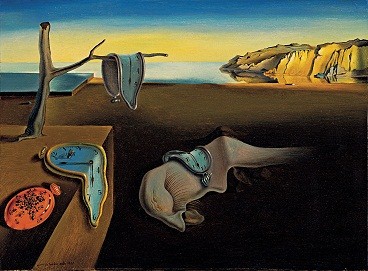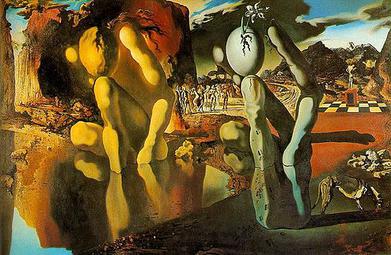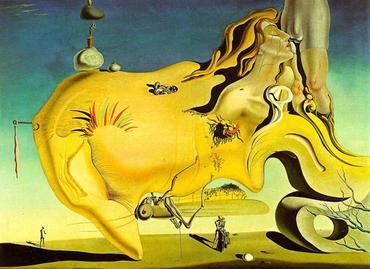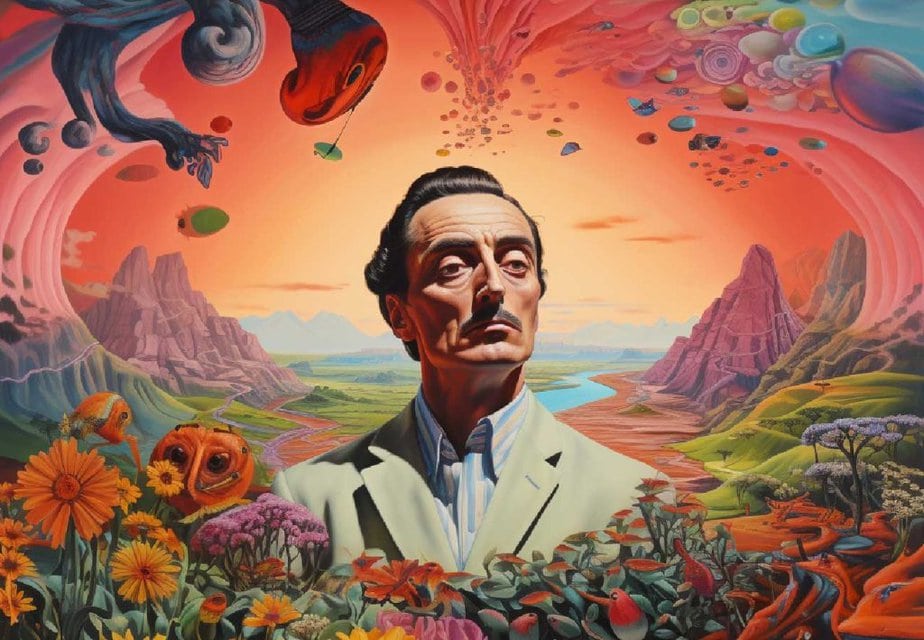Surrealism is an artistic and literary movement that emerged in the early 20th century, championing the exploration of the unconscious mind, dreams, and the irrational. It sought to break away from traditional artistic techniques and rational thinking, instead embracing the power of imagination and the subconscious.
The Surrealist movement was heavily influenced by the psychological theories of Sigmund Freud, particularly his ideas on the unconscious and the interpretation of dreams. Surrealist artists aimed to tap ”what is art” in hidden depths of the mind, unleashing a stream of imagery that defied logic and reason.
Salvador Dalí’s work is filled with psychological complexity, and several aspects of this can be identified:
Symbolism
Salvador Dali’s paintings are rich in symbols, often interpreted as representations of subconscious thoughts and desires.
Paranoia-Criticism
A concept developed by Dalí himself, where the artist uses his paranoia to tap into his subconscious and project it onto his work, creating a reality from his imagination and fears.
Sexual Imagery
There are strong elements of sexuality and eroticism in Dalí’s art, reflecting his own struggles and fascinations with sex, repression, and desire.
Obsession with Death
Dali often explored the theme of mortality, possibly stemming from his early encounters with death and the loss of his mother.
Transformation and Metamorphosis
Many of Dalí’s works depict objects transforming into something else, symbolizing the fluidity of the unconscious mind.
Psychoanalytic Theory
His work is heavily influenced by Freudian psychoanalytic theory, particularly the importance of dreams and the unconscious.
Oedipal Complex
Some of Dalí’s works have been interpreted as depicting the Oedipal complex, a concept central to Freudian psychology.
Religious Symbolism
Dalí’s use of religious symbolism can reflect the psychological struggle between piety and irreverence, faith, and reason.
Dream Imagery
Dalí’s paintings are famous for their surreal and dreamlike quality, vividly depicting the world of dreams and the subconscious.
Fear and Anxiety
His works frequently evoke a sense of angst, a reflection of inner turmoil and existential dread.
The Double Image
Dalí often used the double image, or visual pun, where one painting presents two different scenes when viewed from different angles, reflecting the complexity of the psyche.
Time and Space
He frequently distorted and manipulated time and space, which may represent the subjective nature of human perception and experience.
Self-Image and Identity
Dalí’s numerous self-portraits reveal his preoccupation with self-image and identity.
Obsession with Nuclear Physics and Disintegration
In his later works, Dalí’s fascination with atomic theory led to depictions of disintegration, representing the anxiety of the atomic age.
Hallucinatory Realism
His technique of making everyday objects appear strange and other-worldly reflects the surreal nature of the unconscious mind.
Salvador Dalí, the renowned surrealist artist, was heavily influenced by Sigmund Freud’s psychoanalytic theories, particularly the concept of the unconscious mind.
Dalí incorporated Freudian psychology into his artwork, using it as a source of inspiration and exploring the depths of the human psyche.
One of the critical aspects of Freudian psychology that influenced Dalí was the idea of dreams and the interpretation of their symbolic content.
Freud believed dreams were the “royal road to the unconscious,” where repressed desires and hidden thoughts could manifest themselves.
Dalí was fascinated by the dream world and sought to capture its elusive nature in his paintings.

Dalí’s most famous painting, “The Persistence of Memory” (1931), is a prime example of his exploration of the unconscious and dreams.
The painting’s melting clocks and distorted landscapes reflect the dreamlike quality of the unconscious mind, where time and space lose their conventional meanings.
These surreal elements were a visual representation of Dalí’s interpretation of Freud’s theories on the hidden workings of the mind.
Salvador Dalí was deeply influenced by Sigmund Freud’s theories, particularly those related to the unconscious, dreams, and repressed desires. Freud’s psychoanalytic ideas helped shape Dalí’s approach to surrealism, but one artwork in particular stood out as a direct reflection of Freud’s influence and even led to a significant encounter between the two.
The Metamorphosis of Narcissus (1937)
This painting is often considered one of Dalí’s most Freudian works. It was inspired by the Greek myth of Narcissus, but Dalí reinterpreted it through a psychoanalytic lens. In the painting, Dalí depicts the moment Narcissus gazes at his reflection and transforms into a hand holding an egg with a flower growing out of it. The dual imagery and themes of transformation relate to Freudian ideas about identity, self-reflection, and the fragile boundary between the conscious and unconscious mind.

The painting plays on the concept of narcissism, a psychological condition named after the Greek myth, which Freud extensively wrote about in his theory of personality. Dalí used the paranoiac-critical method to create the double images in this work, aligning it with Freud’s exploration of how the unconscious mind perceives reality.
While The Metamorphosis of Narcissus is often highlighted, other works like The Persistence of Memory (1931) also reflect Freudian themes of time, decay, and the subconscious. Dalí’s entire surrealist approach—focusing on dreams, desires, and hidden fears—was steeped in Freudian psychoanalysis, but this particular painting had the most direct impact on their relationship.
Another aspect of Freudian psychology that influenced Dalí was the concept of sexual symbolism. Freud argued that many seemingly unrelated objects and images could have hidden sexual meanings.
Dalí incorporated sexual symbolism into his artwork, often depicting distorted and exaggerated forms that alluded to erotic and subconscious desires. For example, Dalí’s famous painting “The Great Masturbator” (1929) features a distorted figure with sexual undertones, reflecting his interest in Freud’s theories on sexuality and the unconscious.

In addition to these visual representations, Dalí explored the concept of the “paranoiac-critical method,” a term he coined to describe his artistic approach.
This method involved tapping into the unconscious mind and allowing irrational and instinctual thoughts to influence the creative process.
By embracing the irrational and the subconscious, Dalí believed he could unlock new artistic possibilities and reveal hidden truths about the human condition.
Dalí and Freud’s Meeting
Dalí admired Freud and was fascinated by his writings. In 1938, Dalí finally met Freud in London. He brought The Metamorphosis of Narcissus to show Freud during their meeting, hoping for the psychoanalyst’s insight into his work. Freud was initially skeptical of surrealism but was impressed by Dalí’s technical mastery. However, Freud also mentioned that Dalí’s art had caused him to reconsider his views on surrealism, stating that Dalí was the first surrealist to show him the potential connection between the unconscious mind and visual art.
Overall, Salvador Dalí drew on the concept of Freudian psychology, particularly the unconscious mind, dreams, sexual symbolism, and the paranoiac-critical method, to create his distinctive and thought-provoking artworks.
Dali used these ideas as a foundation for exploring the depths of the human psyche and bringing forth the mysterious and often unsettling aspects of the unconscious onto the canvas.
The article contains sponsored affiliate links from Amazon to valuable resources.


